The following rule changes apply here on yucata.de:
- The events Tribute, Luxury Tax and Flood make all players discard bricks. In
the online implementation this is done automatically by the system for a
more fluid gameplay. The automatic discard algorithm will discard first
those bricks where the user is currently not building a tower and of
those it will discard the cheapest (white, ...).
Game Concept
In the Florence of the 12th-14th centuries, the city’s
powerful and influential families don’t just compete
with each other in trade and politics. They also try to
outdo one another by building tall, mostly square-based
tower homes as status symbols.
In this game, you are master builders working on the
families’ construction commissions for such towers.
You build the towers from different-colored bricks you
receive from the game’s cards. But be careful: once
you’ve started construction on a tower, you must keep
erecting it every turn, or it will be torn down as
abandoned construction. Pay attention to other players’
projects, so that they don’t snatch commissions you
were counting on right from under your nose!
You receive Prestige Points for completed commissions.
Whoever has amassed the most Prestige Points by the
end of the game wins.
The Game Board
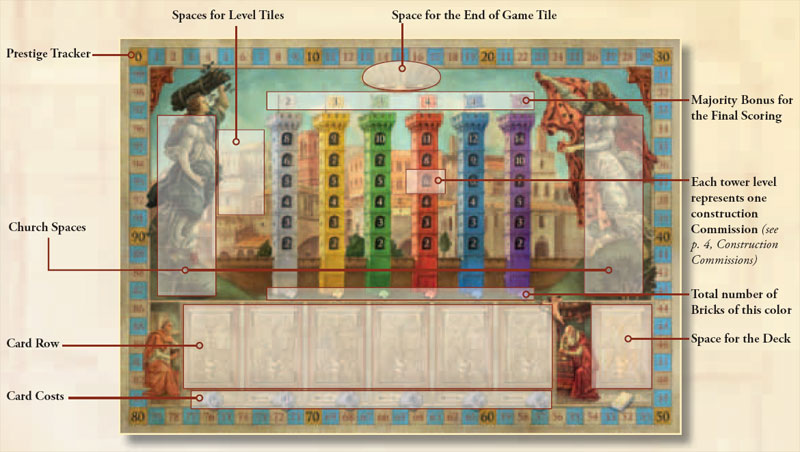
Game Contents
- 1 Game Board
- 88 Bricks:
25x White
18x Yellow
15x Green
12x Red
10x Blue
8x Purple
- 52 Action Cards
- 8 Overview Cards (4x A, 4x B)
- 4 Construction Sites
- 4 Prestige Markers (in the 4 player colors)
- 36 Seals (in the 4 player colors)
- 7 neutral Seals
- 4 small Seals (in the 4 player colors)
- 19 Balcony Tiles
- 4 Level Tiles
- 1 End of Game Tile
- 1 Pouch
- 1 Action Card Overview Sheet
Set Up
1. Place the Game
Board in the
middle of the
players.
2. Place the Level Tiles on the
four small spaces to
the left of the white
tower according to
their respective levels.
3. Place the End of Game Tile
on the oval space above the
two towers in the middle.
4. Turn the Balcony Tiles to the sides with Roman
numerals and shuffle them. Turn over 4 Balcony
Tiles, one I, one II, one III, and one IV. Place these balconies on the Game Board
so that they cover the
appropriate Level of the tower of the appropriate color.
5. Now take the 5 neutral Seals and use
them to cover 5 Levels of your choice
of whatever towers you like, as long
as they don’t already have a Balcony
Tile on them. You can choose any Levels you like.
We recommend that no more than two tiles (Balconies
and/or neutral Seals) be placed on any given tower. In
addition, two or three neutral seals should be set on the
third and fourth Levels. The two leftover neutral Seals are
not required and may be placed back in the box.
6. Each player takes one
Construction Site and one of the
Overview Cards, placing them in front of them.
7. Now each player chooses a
Seal Color and takes the
following number of
Seals, depending on the number of
players, of their chosen color:
- If 2 players: 9 Seals each
- If 3 players: 7 Seals each
- If 4 players: 6 Seals each
8. Whoever was most recently up a tower is the Starting
Player and receives 2 white Bricks. Proceeding in a
clockwise direction, each other player receives one
more brick than the player before, that is: 3, 4, or
5 white Bricks. Place these Bricks below the
Construction Site in front of you (not on the
Construction Site). This is your Storehouse. Place
all the other Bricks in the Pouch, and mix them
up in it.
9.
If this is your first time playing Firenze,
we recommend that you do not use the
Campanile Action Card. Take it out of
the deck and put it back in the box.
When you do play with the Campanile
card, take care that all players know the
effects of the Campanile before the game
begins. You’ll find a description of it on
the accompanying Summary Sheet.
10. Pick the 10 Start Cards
out of the Action Cards. They have the
Start Symbol on the bottom of
front side. Lay them aside for the
moment. Shuffle the rest of the
cards and place them face down
on the space at the bottom right
of the Game Board to make the
Deck.
Now shuffle the
10 Start Cards
and place them
on top of the
Deck, also face down.
11. Turn over the top card of the Deck and place it on
the leftmost space of the Card Row. Then place the
second card on the second space, the third card on the
third space, etc., until all six spaces of the Card Row
are occupied. Now place 4 Bricks drawn randomly
from the Pouch on each of the six cards in the Row.
Construction Commissions
In the top part of the Game Board, you’ll see six towers. They have the same colors as the Bricks. Each Level of the
towers is a symbol for a different Construction Commission. The small numbers to the left indicate how many
Levels a tower requires to fulfill the commission. The large numbers indicate how many Prestige Points you receive
for fulfilling the commission.
In total, there are 36 Commissions. The Commissions which have already been covered by neutral Seals are not
available in that particular game. Once you fulfill a Commission, cover it with your personal Seal. Each Commission
may only be executed once.
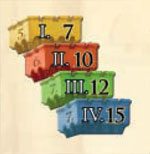
|
Balconies
Balcony Tiles cover 4 Commissions. These balconies represent Special Commissions
for particularly lavish towers and therefore yield additional Prestige Points. The
Balcony Commissions can only be performed in a particular sequence, as indicated by
the Roman numerals. At the beginning of the game, only Balcony Commission I may
be undertaken. Then, only after one player has executed that Commission, may Balcony
II be undertaken. After II’s fulfillment, III can be undertaken, etc.
|
Game Play
Beginning with the Starting Player, each player takes a turn in clockwise
order. Only the player whose turn it is may act. Each turn is divided into
up to six phases, which proceed in the following order:
1) Choose a card (mandatory)
2) Exchange Bricks (optional)
3) Build Towers (optional)
4) Tear down abandoned construction (mandatory)
5) Fulfill Commissions (optional)
6) Check Limits (mandatory)
1) Choose a card
When it’s your turn, you must first choose exactly 1 of the 6 face-up
Action Cards in the Card Row. The symbol on the Game Board below
the chosen card shows how many Bricks must be paid for the card in
question. We call these prices Card Costs. The card at the far left is free.
The others each cost one Brick more than the one to its left.
In order to pay the Card Costs, you must withdraw the corresponding
number of Bricks from your Storehouse. Place one Brick on each Card
Row card to the left of your card. You can use any color Brick to pay
these Costs.
Tip: Pay attention to the correct order. You must pay the Costs
before you can take the Card and the Bricks. That is, you may not
use the Bricks on the chosen Card to pay for it!
Now take the chosen Card along with the Bricks on top of it on the
Game Board. Place the Bricks in your Storehouse. What happens with
the card depends on the Symbol at the top left of the card.

|
-You must play Event Cards immediately.
-Put Personnel Cards into your hand. You can play them
immediately or later, whenever it’s your turn.
-Put Celebration Cards into your hand, where they will
normally remain until the end of the game.
-Put Building Cards in front of you face up. You can use them
at any time, starting immediately.
-Place Church Cards on the Church Spaces face up.
|
There is now a hole in the Card Row. Move all the cards to its right one place to the left
(in the direction of the arrows). Then turn over the top
card of the Deck and place it on the now-open, rightmost field. Take 4
Bricks from the Pouch and put it on the new card.
Tip: In the unusual case that the Pouch has fewer than 4 Bricks,
simply place all the Bricks left in the Pouch on the card. Bricks are
not added to the card when someone places Bricks back in the Pouch!
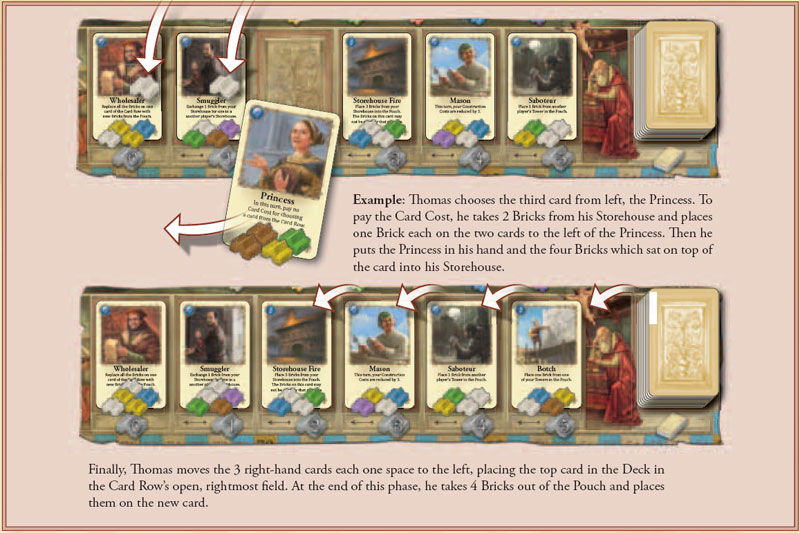
2) Exchange Bricks
|
You may swap 1 Brick of your choice from a card in the Card Row for
3 Bricks from your Storehouse. Simply place the 3 Bricks from your
Storehouse on the card where the Brick you want is sitting, and place the
desired Brick in your Storehouse. You may choose the 3 Bricks’ colors
freely.
You may conduct at most one such exchange per turn. Exchanging Bricks
is completely optional; you may simply skip this phase.
|
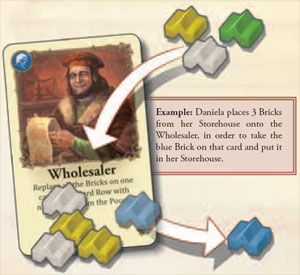
|
3) Build Towers
In this phase, you can use the Bricks in your Storehouse to build or
expand Towers. The following rules of construction apply:
- 1 Brick = 1 Level.
- Each tower must be of a single color.
- Towers must always be built on the Construction Site.
- You may begin new towers as well as continuing work on towers
already under construction.
- You can build as many towers as you like at one time. The towers
may differ in color or be of the same color.
- Towers may not be reduced in size.
- You may add on at most 6 Bricks per turn.
- 2 Bricks per turn can be used for free. If you want to use more
bricks, you must pay for them in the form of additional Bricks from
your Storehouse. We call these costs Construction Costs.
|
The Construction Costs are assessed according to the total number of
Bricks used for building in this turn:
1 Bricks used to build --> 0 Construction Cost
2 Bricks used to build --> 0 Construction Cost
3 Bricks used to build --> 1 Construction Cost
4 Bricks used to build --> 3 Construction Cost
5 Bricks used to build --> 6 Construction Cost
6 Bricks used to build --> 10 Construction Cost
It is immaterial for the assessment of Construction Costs how many
towers are being built or how high they are. The sole factor assessed is the
total number of Bricks used during this turn.
In order to pay the Construction Costs, simply move the appropriate
number of Bricks from your Storehouse to the Pouch. The colors of these
Bricks don’t matter. You may choose them at will, regardless of the colors
of the Bricks you’re using to build.
|
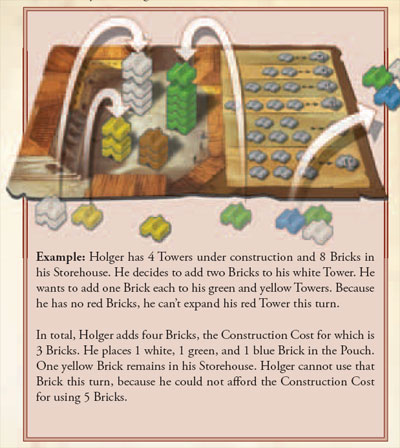
|
4) Tear down abandoned construction
All the towers on your Construction Site that were under construction
at the beginning of your turn but were not worked on are considered
abandoned construction. You now have to tear them down. Place half of
such towers’ Bricks into the Pouch (rounding odd numbers up). Place the
remainder in your Storehouse.
5) Fulfill Commissions
In this phase, you may choose whether you wish to use any of your Towers
to fulfill a Commission, or if you want to continue building them. You
may only fulfill Commissions that are not covered by a Seal. You may
only fulfill the Balcony Commission with the lowest Roman numeral.
The number of Levels (i.e., Bricks) in a Tower must match the number
in the Commission exactly. There can be no more and no fewer Levels.
To fulfill a Commission, complete the following steps:
a) Declare out loud which Tower you want to use.
b) Take the number of Prestige Points indicated on the Game
Board, by moving your Prestige Marker forward a corresponding
number of spaces.
c) Cover the Commission you executed with one of your Seals.
d) Put all the Bricks of the Tower in question in the Pouch.
Then you can fulfill other Commissions. If you have executed a Balcony
Commission, you may fulfill the next Balcony Commission in the same
turn.
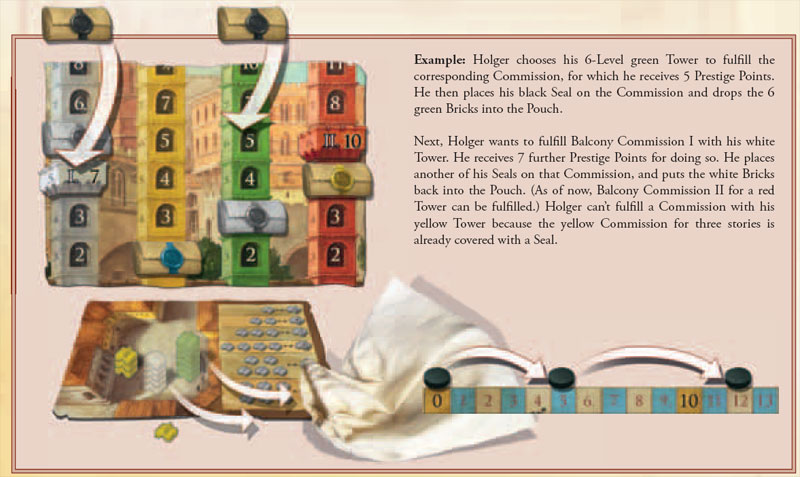
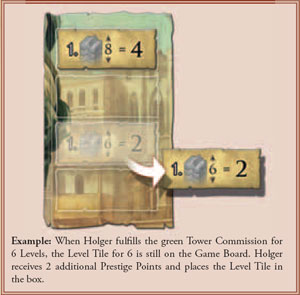
|
Level Bonus
At the left next to the white tower are 4 Level Tiles. These award a bonus
to the first player who fulfills a Commission for the corresponding Tower
height. This Commission may also be a Balcony Commission. If you
receive this bonus, move your Prestige Marker ahead the number of spaces
given. Place the Level Tile back in the box, as each bonus is only given
once.
|
6) Check Limits
When your turn is over, you must check 2 limits, the Storehouse Limit
and the Card Limit. These limits only apply in this phase—i.e., earlier in
the turn they can be exceeded as much as you like; they only apply at the
end of the turn.
The Storehouse Limit means you may have at most 10 Bricks in your
Storehouse. (The Bricks of the Towers on your Construction Site are
not counted for this purpose.) If you have more than 10 Bricks in your
Storehouse, you must surrender enough Bricks to the Pouch to bring you
down to 10 Bricks. You may choose the colors of the surrendered bricks
freely.
The Card Limit means you can possess at most 5 Action Cards. All
Personnel and Celebration cards in your hand, and all Buildings you
have in play count towards this limit. If you have more than 5 Action
Cards, you must put enough Personnel and Building Cards in the
discard pile until you only have 5 cards left.
In general, you may not discard Celebration Cards during this phase.
Even if someone has more than 5 Celebration Cards, they are not allowed
to discard any. Here, in an exception to the rule, they are able to keep
more than 5 cards in their hand—though they must discard all Personnel
and Building Cards.
The End of the Game
|
The first player who places their last Seal on the Game board, receives a
bonus of 5 Prestige Points as a reward. They take the End of Game Tile
and place it in front of them face-down.
All other players receive exactly one more turn. The game ends, therefore,
with the turn of the player to the right of the one with the End of Game
Tile. Then, there is a Final Scoring.
Final Scoring
First, the Majority Bonus is given for each tower color. This bonus is
shown for each color on the flag flying from top of the tower on the Game
Board. It is given to the player who has fulfilled the most Commissions of
this color, that is, the one who has most Seals on the tower of that color.
(Balconies count normally.) In case of a tie, the bonus goes to the tied
player who executed the biggest Commission (as measured in Levels),
that is, the one whose Seal is the highest on the tower.
Now turn over all your Celebration Cards and move your Prestige
Marker forward or backwards, as appropriate. Whoever ends with the
most Prestige Points wins. In case of a tie, there are multiple winners.
|
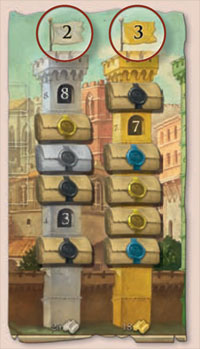
|
Action Cards
In general, if the text of an Action Card contradicts the general rules in
these instructions, the card text always takes precedence. The abbreviation
PP on the cards stands for Prestige Points.
In the course of the game, it will transpire that you’ll discard cards. As
you do so, build a Discard Pile next to the Game Board. When the Deck
on the Game Board is all used up, shuffle all the cards in the Discard Pile
and use them as a new Deck.
There are five kinds of Action Cards, which can be differentiated by the
Symbol at top left.
Event Cards
If, during your turn, you choose an Event Card, you must
immediately follow the instructions on the card. If the card
does not explicitly state that all players are affected, then
the effect only applies to the player whose turn it is. After
following the instructions, discard the card.
Personnel Cards
If you pick a Personnel Card, place it in your hand. You
may play the card immediately or at a later point in the game.
However, it must be during one of your turns. In any given
turn, you may play as many Personnel Cards as you wish, just
not two or more cards with the same name. Personnel Cards
that have been played are put into the discard pile.
Celebration Cards
A player who selects a Celebration Card places it in their
hand. (One exception is the Monument card, which a player
may receive even if it’s not their turn.) The card remains there
until the End of the Game. You may not discard it, even if
you have exceeded the Card Limit. (Only the Patrician card
allows you to discard Celebration Cards.)
Building Cards
If you draw a Building Card, place it face up in front of
you. You may use its function from then on out. You may
not possess two identical Buildings. You may draw identical
Building Cards, but they must be put in the Discard Deck
immediately. (If, for example, you have already played a
Workshop, you may take another Workshop from the Card
Row but you must discard it immediately.)
Church Cards
Any Church Card chosen is placed face up on one of the
4 Church Spaces. It remains there until its effect is fulfilled.
Thereafter, it’s placed in the Discard Pile.
Action Cards Summary
Alchemist (4x)
You may swap any one Brick from your Storehouse
for any one from the Pouch. You may look into the
Pouch to find a particular Brick.
Architect (3x)
Play this card during the Fulfill Commissions phase.
You may count one tower as one Level taller or
shorter during this turn. E.g., you can score a yellow
tower with 3 Levels as if it had 4 Levels. You could
also score a Tower with 2 Levels as having 3, or one
with 9 Levels as if it had 8.
Botch (1x)
Choose 1 Tower on your Construction Site. Put
one Brick from that Tower in the Pouch.
Bridge (1x)
When you perform an exchange in the Exchange
Bricks phase, you must give up one fewer Brick.
Instead of 3 Bricks for 1, you now switch 2 for 1.
You are still limited to only one exchange per turn.
Campanile (1x)
If a player chooses the Campanile card from the
Card Row, they place it (like with all Church cards)
onto one of the Church spaces on the Game Board.
Then, all players must build a bell tower out of
3 white Bricks. Until a player’s bell tower is
finished, they may not fulfill any other Commissions!
Nevertheless, you must keep adding to
any Towers under construction or tear them down
as abandoned.
Upon finishing the bell tower, players place the white Bricks back in
the Pouch during the Fulfill Commissions phase and put their small
Seal on the Campanile card. They may immediately execute other
commissions—even in the same turn.
The card remains on the Game Board until every player has placed his
small Seal on it. Then, everyone takes their small Seal back, and the card
is placed on the Discard Pile.
Collapse (1x)
You must tear down 1 Tower on your Construction
Site. All of this Tower’s Bricks go into the Pouch. If
you have no Tower under construction, nothing
happens.
Disgrace (2x)
You have to give up 2 Prestige Points in the Final
Scoring.
Fame (2x)
You receive 3 Prestige Points in the Final Scoring.
Flood (1x)
All players are affected by this card. Put a third
(rounding up) of your Storehouse Bricks in the
Pouch. E.g., if you have 4 Bricks in your Storehouse,
you have to round the number 1.33 up to 2. You
may choose the Bricks’ colors at will. The Bricks on
the card do not count towards the total, and are not
put into the Pouch.
Luxury Tax (1x)
All players are affected by this card. For every
Tower on their Construction Site that has at least
5 Levels, the builder must pay 2 Bricks. The colors
of these Bricks don’t matter and are unrelated to the
colors of the Towers.
Any tower for which the builder cannot pay is torn
down. Half the Bricks (rounding up) are placed in the Pouch, the other
half (rounding down) into the builder’s Storehouse. You may not tear
town a Tower voluntarily, but must pay the tribute if possible.
Major Privilege (1x)
This card remains face up on a Church space until a
player fulfills a commission of exactly 7 Levels. This
player then immediately receives an additional
4 Prestige Points. Then place the card on the
Discard Pile.
Mason (3x)
Play this card during the Build Towers phase. You
pay three fewer Bricks in Construction Costs this
turn. E.g., 4 Bricks cost no Bricks, 6 Bricks cost 7.
If you also own a Workshop you pay 4 less bricks
instead of 3. A negative number is regarded as zero.
Minor Privilege (1x)
This card remains face up on a Church space until a
player fulfills a commission of exactly 5 Levels. This
player then immediately receives an additional
2 Prestige Points. Then place the card on the
Discard Pile.
Monument (2x)
If a player chooses this card from the Card Row,
determine who has the tallest Tower on their
Construction Site. This player puts the card in their
hand, even if it’s not their turn. If a tie, no one
receives the card; it goes on the Discard Pile.
In the Final Scoring, the holder of the card receives
3 Prestige Points.
Patrician (3x)
This card may be used in 2 different fashions. Either
you may ignore the effect of an Event Card that
you chose during the Choose a card phase of your
turn, or you may spend the Patrician to discard one
card from your hand (e.g., Disgrace or Scandal).
Princess (2x)
Play this card during the Choose a card phase. You
must pay no Card Cost this turn when you choose
a card from the Card Row.
Privilege (1x)
This card remains face up on a Church space until a
player fulfills a commission of exactly 6 Levels. This
player then immediately receives an additional
3 Prestige Points. Then place the card on the
Discard Pile.
Recognition (2x)
In the Final Scoring, count up all the 3- and 4-Level
Commissions you’ve fulfilled. You receive that
many Prestige Points.
Renaissance (1x)
Shuffle the Discard Pile and the Deck together (not
the Card Row!), and use the result as your new
Deck. The Renaissance card must be shuffled in as
well. Then, refill the Card Row from the new Deck.
Saboteur (1x)
Choose a Tower of another player. Take one Brick
from it and put it in the Pouch.
Scandal (2x)
You lose 3 Prestige Points in the Final Scoring.
Smuggler (3x)
You can switch one Brick from your Storehouse
with one from another player’s Storehouse. You can
choose both Bricks freely.
Storehouse Fire (2x)
You put 3 Bricks from your Storehouse into the
Pouch. The colors of the Bricks may be chosen
freely. The Bricks on the card may not be used for
this. If you have fewer than 3 Bricks, just put all
your Bricks in the Pouch.
Tribute (2x)
All players are affected by this card. For every
Tower on their Construction Site, each builder
must pay 1 Brick of the Tower’s color.
Every Tower for which the builder cannot pay is torn
down. Put half (rounding up) of the Bricks in the
Pouch, and the other half in the builder’s Storehouse.
You may not tear down a tower voluntarily, but must pay the tribute if
able.
Warehouse (3x)
In the Check Limits phase, you may keep 5
additional Bricks in your Storehouse, that is, a
maximum of 15 Bricks. In addition, you may keep
as many cards in your hand as you wish.
Wholesaler (2x)
Play this card during either the Choose a card or the
Exchange Bricks phase. Choose one card from the
Card Row and note the number of Bricks on it.
Place all of that card’s Bricks in the Pouch and
shuffle the Pouch. Draw the same number of Bricks
from the Pouch and put them back on the card.
You are not required to choose this card during the
Choose a card phase.
Workshop (4x)
When paying the Construction Costs in the Build
Towers phase, you pay one Brick fewer. This remains
as long as you have the card in front of you. E.g.,
3 Bricks cost 0, 4 Bricks cost 2. If you also play a
Mason you pay 4 less bricks instead of 1. Negative
numbers are regarded as zero.